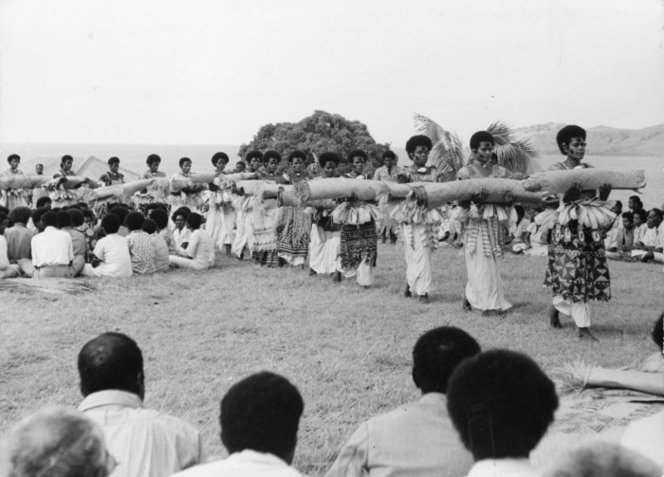Presentation of Fijian mats and tapa cloths to Queen Elizabeth II
Presentation of Fijian mats and tapa cloths to Queen Elizabeth II. Fiji, Polynesia. 1953 C.E. Multimedia performance (costume; cosmetics, including scent; chant; movement; and pandanus ber/hibiscus ber mats), photographic documentation.
- On December 17, 1953, a newly crowned Queen Elizabeth II and her husband Prince Philip, Duke of Edinburgh, arrived on the island of Fiji, then an English colony.
- The first thing you might notice in the photograph is the procession of Fijian women making their way through a group of seated Fijian men and women.
- Several of the processing women are wearing skirts made of barkcloth painted with geometric patterns.
- Barkcloth, or masi, as it is referred to in Fiji, is made by stripping the inner bark of mulberry trees, soaking the bark, then beating it into strips of cloth that are glued together, often by a paste made of arrowroot.
- Bold and intricate geometric patterns in red, white, and black are often painted onto the masi; often presented as gifts in important ceremonies such as weddings and funerals, or to commemorate significant events, such as a visit by the Queen of England.
- What is definitely evident from the photograph are the rolls of woven mats that each woman in the procession carries. Like masi, Fijian mats served and continue to serve an important purpose in Fijian society as a type of ritual exchange and tribute.
- Made by women, Fijian mats are begun by stripping, boiling, drying, blackening, and then softening leaves from the Pandanus plant. The dried leaves are then woven into tight, often diagonal patterns that culminate in frayed or fringed edges.
- While the mats that the women in this photograph are carrying may seem too plain to present to the Queen of England, their simplicity is an indication of their importance. In Fiji, the more simple the design, the more meaningful its function.
